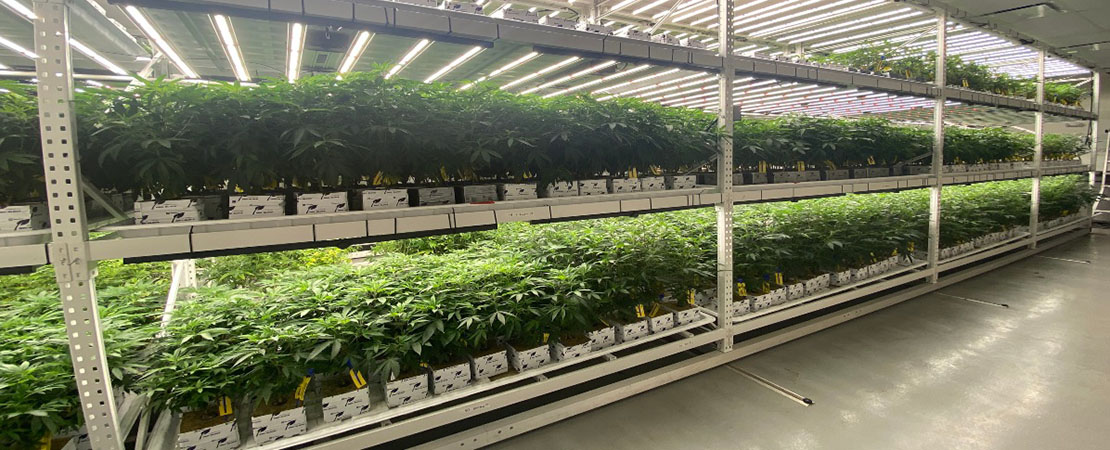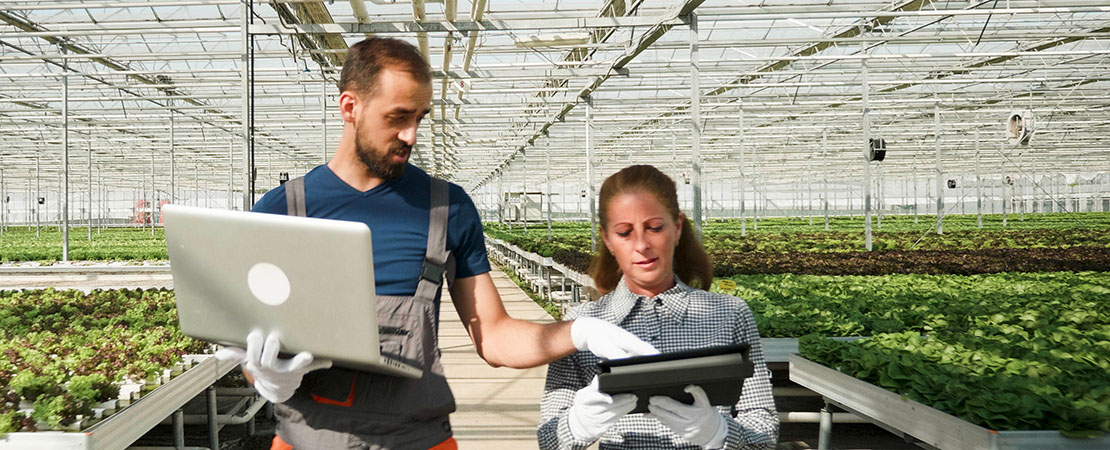Vertical Farming Trends That Will Cultivate The Future Of Indoor Cannabis Farming
Are you aware of these four vertical farming trends that are revolutionizing the cannabis sector?
By 2050, the global human population is expected to reach 9.7 billion. Two-thirds of that population is expected to be in cities. This migration creates a need for innovation to improve sustainable food production to feed the world’s growing population. The problem, however, is a scarcity of arable land and natural resources in urban areas.
Vertical farming is one emerging agricultural trend that is helping to bridge the food demand gap in urban areas.
Cannabis indoor farmers are adopting vertical farming to help double or even triple their yields.
Vertical farming increases crop yields using 99 percent less land and 98 percent less water than conventional farming.
Vertical farming is managed by CEA (controlled environment agriculture) technology, which can be done almost everywhere, from skyscrapers to warehouses, or shipping containers. This progression is because indoor farms are stacked vertically rather than running horizontally on a plot of land.
Furthermore, the market for vertical farming is expected to grow from $3.1 billion in 2021 to $9.7 billion by 2026.
Notably, four vertical farming trends are influencing this innovative farming method and the agricultural scene as a whole.
1. Vertical Farming Operations Are Embracing Multi-Tier Grows Instead of the Standard Single Tier
Vertical farming equipment is essential for effective commercial indoor farming. These structures serve as farms, with plants stacked in trays on shelves.
A multi-tier rack system makes better use of unused cubic feet in overhead space. Going up means you won’t need to buy more land to grow more.
The racks are custom made and built with up to multiple tiers depending on state regulations, effectively doubling or tripling your available grow space.
MMI Agriculture is a market leader in multi-tier grow rack systems that are long-lasting and dependable. The mobile systems are custom designed to meet the client’s needs, providing flexibility and cost savings based on available space and size of the operation.
The vertical systems made with multiple tiers filled with plants to capacity can become cumbersome to move when installed on wheels.
MMI Agriculture mitigates this problem with a rolling bar system that holds your shelving in place and allows you to single-handedly move the racks. The mobile carriage will enable you to create or close aisles as needed.
Furthermore, as hydroponics takes center stage in the cannabis vertical farming space, MMI Agriculture has built vertical systems that accommodate these resource-saving cultivation methods, ensuring an efficient indoor farm.
Vertical farming, like any other solution, presents a challenge. Vertical farming must account for the emergence of microclimates. More tiers create various environments for each plant at various heights.
This problem introduces us to our second trend in vertical farming, artificial intelligence, which allows for microclimate management.
2. Artificial Intelligence (AI) For Vertical Farming
Other vertical farming trends to check out for in 2023 is the use of AI.
Incorporating artificial intelligence into vertical farming can increase productivity by 400%. Plenty, a San Francisco-based Ag-tech company, has used artificial intelligence to boost production and productivity.
Although the farm is only 2 acres, it produces 720 acres worth of fruit and vegetables. Vertical farming and production management with robots and artificial intelligence have made this possible.
The AI monitors light, temperature, and the environment of the plants. As a result, you can grow high-quality crops faster.
Furthermore, AI in agriculture is designed to help address labor shortages by incorporating smart irrigation and farming systems and other AI-based robots and technology. It reduces the need for personnel in a grow room. AI tools are also more accurate and faster.
The AI-powered robots are self-sufficient and can work 24 hours a day, seven days a week. This results in a better workforce to meet rising cannabis demand.
AI is also being used in farming to assist with data analytics. The tool can provide insights in real-time.
This action assists farmers in determining how to control pesticide application, indoor weather, irrigation, and fertilization. They can also accurately determine excess or missing nutrients in your growing medium.
This analysis is due to the AI’s ability to receive data from IoT (Internet of things) sensors that monitor climatic, environmental, and visual information from crop grow medium. The data is then used to train deep learning models, which predict the likelihood of disease occurrence.
The data also helps in predictive analytics. By analyzing market demand, farmers can forecast prices and determine the best time to plant and harvest their cannabis plants. This means that farmers can manage crop failure and business process risks. The data contributes to a new trend known as precision farming.
3. Precision Farming
The average American farm increased from 140 acres in 1935 to 434 acres by 2012. And the acreage continues to increase with modern farms of today.
Farmers use heavy machinery to cultivate large tracts of land. This situation presents a problem because they treat every acre of land the same. This type of farming is known as industrial agriculture. Although it boosts productivity, it comes at the expense of environmental devastation due to excessive tillage and input application.
Precision farming helps solve this problem. At the heart of precision farming is digital technology like IoT, GPS, cloud computing, automation, robotics, and sensors.
Precision agriculture uses digital technology to achieve optimal agricultural efficiency by measuring and adapting the variations in a crop’s environment.
The agricultural method brings in an information-based decision-making approach to farm management. This allows you to accomplish more with less.
The farming method has been critical to the expansion of vertical farming. The technology assists in analyzing the requirements of individual canopies, then it provides the best climatic conditions for their development.
Blockchain technology is also coming into the picture; the technology helps increase transparency in the supply chain. Consumers can understand the quality and origins of the products they purchase.
Blockchain tech complements precision agriculture as the consumers can appreciate the technology and build trust with the products. Knowledge of a commodity’s history also promotes best farming practices, which leads to environmental protection.
The key advantages blockchain technology bring to vertical farming are:
- Transparency– Products are tracked from the farm to the retail shelf.
- Security– Food safety has improved, and counterfeit items have been eliminated.
- Streamlined Operations– You can easily keep up with regulations present in the cannabis industry.
- Analytics– Intelligent market data is available to help with decision-making.
- Customer Engagement– Through feedback, the farmer can better understand what consumers want.
4. Safety In Vertical Farming
The towering nature of vertical farming systems introduces the need for safety measures to be taken in their construction and use. There’s a push to enhance worker safety when tending to crops and remaining OSHA-compliant. The vertical equipment also needs to stay durable in a consistently damp and corrosive environment.
For regions with seismic activity, vertical farms are fitted with anti-tip systems that keep the rolling vertical grow racks from falling over.
MMI Agricultures takes the lead in worker safety by including the above features with more innovations like our patent-pending retractable mezzanine walkway.
The walkway is a lightweight, portable deck that allows your staff to access upper levels of MMI Agriculture’s high-density vertical rack systems. It eliminates the risk of climbing ladders to reach shelving higher up.
The retractable platform integrates seamlessly with the rack system for optimum productivity and safety. When done, it neatly tucks it into the racking system out of view and out of the way.
In addition, whether you have any of our new or existing racks, the mezzanine walkway fits perfectly.
Get Started On Vertical Farming
Vertical farming is the key to sustainable commercial cannabis farming, particularly in urban centers. Partnering with a reputable vertical systems provider will put you on the path to a profitable indoor operation.
MMI Agriculture is a vertical systems provider that works with you throughout the design and installation process to ensure your satisfaction.
We have cutting-edge vertical equipment and a nationwide installation team ready to build your dream cannabis vertical indoor grow room.
Contact us today for a quote.

